Below I refer to John Sayles but maybe the movie Mumford is more like Lasse Hallstrom amused and charmed by a Norman Rockwell America. Whatever it is, and despite a few anachronisms, I still find this movie appealing. It has so many actors in it I’ve always liked. Part of its appeal may be that we don’t often see ensemble pieces like this anymore.
The fantastic western of George Pal
You can see a number of actors best known for their television work in the 1960s and 1970s — Tony Randall, Barbara Eden and Arthur O’Connell — in one of the oddest films: 7 Faces of Dr. Lao.
Is it a fantasy? Without a doubt. Is it a western? I think so. Is it good? Umm … well, that’s one I’ll avoid but I’ll say this — I found it entertaining!
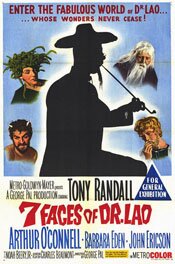 7 Faces of Dr. Lao
7 Faces of Dr. Lao
Directed by George Pal
This movie, 7 Faces of Dr. Lao, is peculiar to say the least, and in its peculiarity is a wonderful fantasy that doesn’t make for the greatest film ever made but a delightful one nonetheless.
Once seen, it’s not surprising to find it is directed by George Pal, who gave us such movies as The Time Machine. Based on a novel by Charles G. Finney titled The Circus of Dr. Lao, the movie is an odd cross between a typical western and fantasies like The Golden Voyage of Sinbad. (That movie was not directed by Pal.)
I make that comparison because you don’t often come across a western that employs old school animation. I believe it was called claymation.
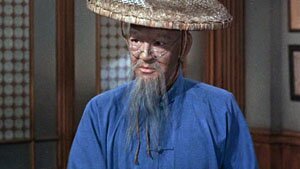 To begin with, though dressed up in western garb the movie takes its first left turn when its lead character, Dr. Lao played by Tony Randall, shows up. He is Chinese – or is he? His accent changes as the situation demands, deliberately. Dr. Lao has brought his circus to the town of Abilone (and Randall plays all the characters in the circus, including Merlin and the Abominable Snowman).
To begin with, though dressed up in western garb the movie takes its first left turn when its lead character, Dr. Lao played by Tony Randall, shows up. He is Chinese – or is he? His accent changes as the situation demands, deliberately. Dr. Lao has brought his circus to the town of Abilone (and Randall plays all the characters in the circus, including Merlin and the Abominable Snowman).
The story is relatively simple and progresses more or less episodically. Dr. Lao comes to a town and using his circus and magic and stories that teach lessons, reveals the town to itself. In doing so, he saves it from disappearing by selling out to a cynical land baron, Clint Stark played by Arthur O’Connell.
The rich and greedy man trying to buy a town to capitalize on a railroad that will soon be coming is a standard, even cliché western story. This movie would be just another, average version of that story except for its fantasy element. (The movie also has its obligatory love story as a romantic John Ericson tries to woo a resistant and bundled-up school teacher, Barbara Eden.)
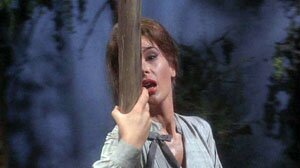 Several things make the movie stand out. The first is the unusual use of an Asian as the lead character – something unheard of for the period (1964) and especially so for a western. However, typical of the period, the Asian isn’t Asian – it’s a white Hollywood actor (Tony Randall) doing a characterization of an Asian (which, like Mickey Rooney’s Japanese man in Breakfast at Tiffany’s, probably makes the hair stand on end for anyone from an Asian country).
Several things make the movie stand out. The first is the unusual use of an Asian as the lead character – something unheard of for the period (1964) and especially so for a western. However, typical of the period, the Asian isn’t Asian – it’s a white Hollywood actor (Tony Randall) doing a characterization of an Asian (which, like Mickey Rooney’s Japanese man in Breakfast at Tiffany’s, probably makes the hair stand on end for anyone from an Asian country).
On the other hand, as it does this it also suggests that Dr. Lao might not be Asian but rather what is actually the case, a white man mimicking a western world idea of a man from China. So the movie plays it cute and cagey in this repect.
Something else that makes the movie unusual (and mentioned already) is the use of claymation. Who on earth ever heard of that in a western? One result of this is to date the movie. Seen today, the movie either has a nostalgic quality for anyone who grew up seeing these kinds of movies or, for many others, it has a retro, kitsch quality.
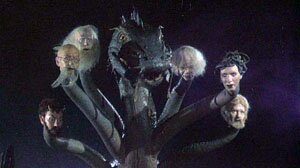 For me, the aspect I find truly interesting, and where I think this movie really veers off from its surface western look, is in how the “bad guy,” Stark, isn’t really so bad. His character is as cynical as he is because as a younger man he was so idealistic. In the end, he is happy because he has lost and thus proven wrong. And throughout the movie, he may be the nicest bad guy movies have ever seen. He’s almost always smiling.
For me, the aspect I find truly interesting, and where I think this movie really veers off from its surface western look, is in how the “bad guy,” Stark, isn’t really so bad. His character is as cynical as he is because as a younger man he was so idealistic. In the end, he is happy because he has lost and thus proven wrong. And throughout the movie, he may be the nicest bad guy movies have ever seen. He’s almost always smiling.
7 Faces of Dr. Lao is not a great movie – not by a long shot. But it is very entertaining, moves quickly, and is a more than a little fascinating for its numerous quirks. And as movies go, it’s about retro as retro gets.
Alec Guinness and Ealing Studios
I’ve just made some minor updates to a few reviews I wrote back in 2002. They’re all Alec Guinness movies (five of them), all done at Ealing Studios, and all come from an earlier part of the actor’s career. By the way, they’re all great.
The Alec Guinness Collection
Ealing Studios: 1949 – 1955
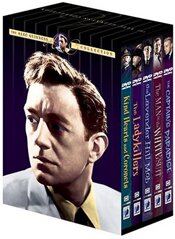
For some, Alec Guinness is the guy from Star Wars (Obi-Wan-Kenobi). For others, such as myself, he’s Colonel Nicholson from The Bridge on the River Kwai. But prior to these, and the many other dramatic roles he played brilliantly, Guinness was known as the comic genius of a series of British films made primarily in the 1950s at Ealing Studios. (They have their web site here.)
The Alec Guinness Collection from Anchor Bay brings together 5 of these films, all of them comic gems. (Update: This collection was brought out by Lion’s Gate in 2009 in the U.S. and Canada.)
What is interesting about these films is that Guinness’ performance isn’t that far removed from the kinds of performances he gave in dramatic roles. In other words, he knows that what makes these roles funny lies in playing them straight. It is the situation that makes the roles funny and the supporting casts, which are usually made up of character actors (often playing caricatures rather than characters).
The conceit informing most of the films is the secret life of a quiet, middle-class British man. Generally, the characters Guinness is playing are extremely British and a bit bookish perhaps. They are the sort of man no one would notice, for the most part, or, if noticed, be seen as very proper and respectable.
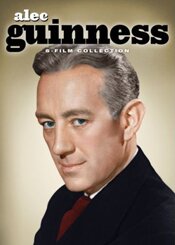
But each of these characters has a secret life they are living. Sometimes it’s criminal, like the caper in The Lavender Hill Mob; in the case of The Captain’s Paradise, it’s an adulterous relationship. Also in common is the secret life these small, quiet men dream of.
That is at the core of the films — the fantasies of the domesticated, perhaps even socially emasculated, male. The humour comes out of the collision between the reality and the fantasy. It develops out of the character’s attempts to hold on to his fantasy.
In most of the films, the Guinness character ends up facing a comeuppance, the triumph of reality over fantasy. However, this doesn’t always mean the character loses. In fact, even when he does lose there is something in the way the ending is handled that makes us feel he has somehow won.
Brevity and excellent pacing also characterize the films. This, combined with Guinness’ flawless performances, makes the movies work.
The Alec Guinness Collection:
- Kind Hearts & Coronets
- Lavender Hill Mob
- The Man in the White Suit
- The Captain’s Paradise
- The Ladykillers
Links:
- The Alec Guinness Collection on Amazon
20 movies: The Core (2003)
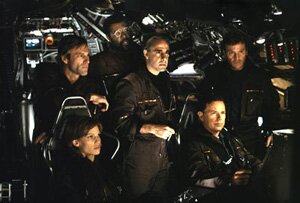 It’s summer. Surely that calls for a “popcorn” movie? I suggest The Core (2003), a “world facing imminent destruction that only a well chosen quirky few can save it from,” kind of movie.
It’s summer. Surely that calls for a “popcorn” movie? I suggest The Core (2003), a “world facing imminent destruction that only a well chosen quirky few can save it from,” kind of movie.
You don’t look to disaster movies for credibility. A disaster movie that takes itself too seriously … now that is a genuine disaster. They’re suppose to be fun and you are suppose to watch them with your brain turned off. When they are well made, they are fun. And there’s a great sense of relief in turning off the mental works every now and again.
The Core doesn’t have the best special effects but neither does it have the worst. It does, however, have some very good actors and while movies like this aren’t famous for great dialogue or character delineation, the actors here manage to bring something more to an otherwise two-dimensional script.
In other words, I like this movie. Sue me. 
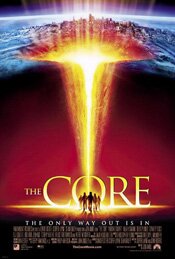 The Core
The Core
directed by Jon Amiel
Simply put, The Core is a guilty pleasure. I watch a disaster movie like this and think, “This is junk. I shouldn’t like it.”
But I do. Sometimes junk is exactly what you want. And when you’re in that mood, nothing fills the bill better than well-made junk.
And that is what The Core is: well-made junk.
The movie starts with the world going wonky. People with pacemakers suddenly drop dead and for no apparent reason. In Trafalgar Square, birds go mad, swirl wildly, fly into people and buildings, and die.
Called in my the U.S. government, a brilliant university professor (Aaron Eckhart) goes, “Hmmm.” He divines that the earth’s electromagnetic (EM) field is going all to hell. After some pondering, it’s discovered the Earth’s core has stopped spinning (made of two layers — inner solid, outer liquid — the movement of the inner is what creates the EM field, we’re told).
What to do? As it turns out, the answer is to travel to the core and jump start the laval ring with nuclear bombs. (Seems obvious, right?)
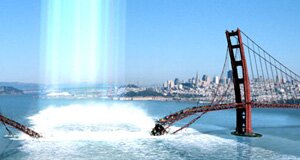 The plausibility of any of this is irrelevant. Movies of this kind are not about reality. They are essentially fantasies, science fantasies, and we’re expected not to question too much. It’s part of the bargain you make when you sit down with this kind of a film.
The plausibility of any of this is irrelevant. Movies of this kind are not about reality. They are essentially fantasies, science fantasies, and we’re expected not to question too much. It’s part of the bargain you make when you sit down with this kind of a film.
And that’s okay. You don’t watch these movies for the credibility of the extrapolations. You watch them for the thrill, the special effects, the suspense.
The Core delivers on all of these, though the special effects are … well, not top of the line. I think the movie works because it is well-paced. It seldom lets up; once you’re strapped in to your chair, agreed to the suspension of disbelief, you’re there for the duration. The g-force of the pace keeps you in your seat.
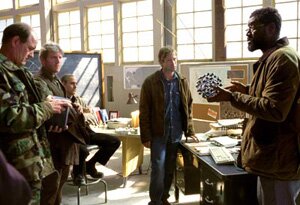 But The Core also works because it gets such good performances from a well-chosen cast.
But The Core also works because it gets such good performances from a well-chosen cast.
In this kind of movie, the characters are all caricatures. There is not a great deal of depth to any of them. But with a good cast they flesh out and transcend their two-dimensional quality and become compelling.
As the DVD features reveal (a “Making of” featurette) the director, Jon Amiel, was focused on the characters. He wanted to make a popcorn disaster movie but with more character emphasis than normally associated with these kinds of movies.
It’s not surprising from Amiel, given his background. As this part of his IMDb bio says, “After studies in English literature, Jon Amiel graduated from Cambridge University and ran the Oxford and Cambridge Shakespeare Company, which often toured the USA. He became the Hampstead Theatre Company’s literary manager and began directing there, relocating to the Royal Shakespeare Company.”
Yes, I can see why there is a focus on performance. For example, Bruce Greenwood gets what might be a thankless role as Commander Richard Iverson, the stereotype of the all-American good guy, a tremendously dull role. But Greenwood is so good in it, so compelling and credible, the character becomes interesting and you sort of wish he had been the one playing the President in Independence Day. (On the other hand, he’s such a good actor we probably shouldn’t wish such bad lines on him.)
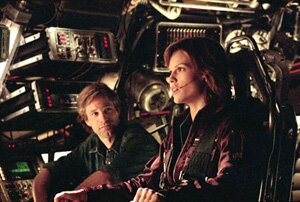 Hilary Swank also plays her part perfectly and again in what might have been a pretty colourless role. Once more, the all-American hero is what is called for, the good guy (or gal). Yet she manages to enunciate certain nuances to give the character a depth it might not otherwise have.
Hilary Swank also plays her part perfectly and again in what might have been a pretty colourless role. Once more, the all-American hero is what is called for, the good guy (or gal). Yet she manages to enunciate certain nuances to give the character a depth it might not otherwise have.
Of course, this isn’t to say the movie is a character study – far from it. But in this kind of a film, great performances add a dimension to the film that it otherwise would not have had and make it much more engaging.
The movie also boasts two of my favourite actors, both of whom give wonderful performances as eccentrics of a kind: Delroy Lindo as a desert-living, oddball scientist and Stanley Tucci as the other great American scientist, celebrated and feted wherever he goes, and who has the misfortune of being an enormous, self-centred ass. Both Lindo and Tucci add tremendously to the film.
Like any guilty pleasure, The Core is the kind of movie you feel a little embarrassed liking. But it’s unashamed junk and revels in its quality as such. Like movies such as Anaconda and Independence Day, it is simply a fun ride.
Who cares if it makes sense?
The Core (trailer)


